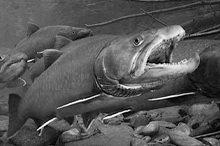No products in the cart.
Our Trout

The Stuff of Dreams
By Gary Oberbillig
Back in 1946 when I was nine years old, my stepfather, Austin Case, worked as a mechanic for a tractor company in Boise. He got a call to take a trip into the mountains to repair the bulldozer blade on a Caterpillar tractor.
As it happened, the Cat was near what’s now alternately known as Paradise Hot Springs or Trinity Hot Springs, in the Trinity Mountains. As a special treat, Austin arranged to take me and my mom along for a mini-vacation, to soak in the hot springs and breathe the bracing mountain air.
This was the day when I caught my very first bull trout, which was my first trout of any kind. Back then, boys regarded bull trout as “our trout,” from our own mountain state, and we felt a little proprietary about them. Technically, they’re not trout at all but are char, like the Arctic char, or the Eastern brook “trout,” or the lake “trout,” or the bull’s close relative, the Dolly Varden.
I once had an argument about this with my dad, Ernest Oberbillig, and he was right. I claimed that bull trout and the more coastal Dolly Varden were one and the same. But he had seen a notification that the two fish were reclassified into different species in 1980. This is primarily because Dollys are anadromous (they run to saltwater, like salmon do), while our bull trout are an inland mountain fish.
Anyway, in those days Paradise Hot Springs was simply a hot pond squirming with garter snakes. Initially, I was leery of them and any snakes, which I worried might turn out to be rattlers. Of course, garter snakes are harmless, and they turned out to be more leery of us than the other way around. They slithered away and kept their distance.
The big attraction for me was not the hot springs but the South Fork Boise River and any fish it might hold. The owner of the broken tractor showed me the simple fishing tackle he used and kindly offered to teach me how to go about it. Instantly, I was transported to an Idaho boy’s happy hunting grounds.
My first question was, “What kind of bait should we use?” My guide answered by grabbing a four-pronged table fork from the kitchen. Puzzling over how to dig angleworms with a table fork, I followed him down to the river’s edge, where he began turning over small rocks in the shallows.
Shortly, he struck pay dirt: under a flat rock lay a creature as menacing as any river monster I’d ever seen, a two-inch underwater segmented thing with efficient-looking mandible pincers. It was a hellgrammite, the water-dwelling larval stage of a dobsonfly. In its adult form it would be a largish insect, about the size of a big dragonfly.
This content is available for purchase. Please select from available options.
Purchase Only
Purchase Only

